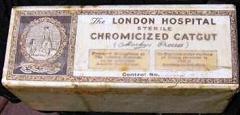Catgut is a type of cord that is made from the walls of animal intestines.

Sheep or goat intestines are usually used to make catgut, but the intestines of a hog, horse, mule, pig or donkey are sometimes used.
Catgut is never made from cat intestines, even though it is possible.
To make catgut, the intestines are cleaned and boiled for some time in water. After the external membrane is scraped off, it is dyed if necessary, sorted into sizes, and twisted together into cords from a number of strands.
Lean animals make the toughest gut, and the best catgut is from Italy and called “Roman strings.”.
Catgut was commonly used for the strings of harps, violins, other stringed musical instruments, tennis rackets and even surgical sutures for stitching wounds.
Catgut is still used as a high-performance string in tennis rackets, but its used has declined in popularity and has been replaced by synthetic strings.
If real catgut is used, it takes the small intestines of eleven sheep to string just one racket.
The word “catgut” is probably an abbreviation of the word “cattlegut”.
Others believe the word originated from from “kitgut”, or “kitstring”, and the word “kit”, meaning fiddle, might have been confused with the word kit for little cat.
